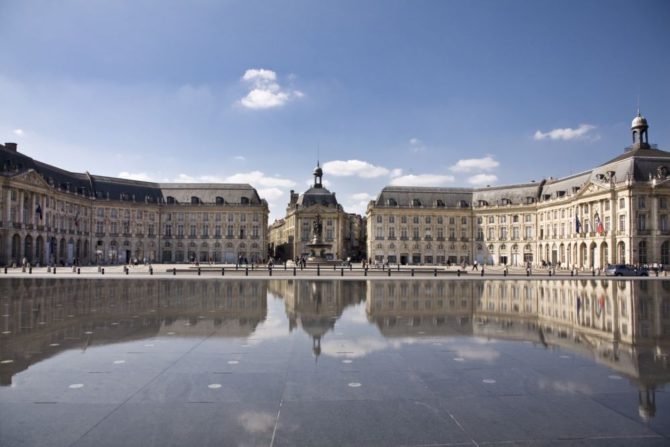Betting on Bordeaux

Real estate agents in the Gironde département in the Aquitaine region of southwest France say they have noticed a marked increase in inquiries and subsequent property sales in the Bordeaux area over the last year. The trend has been confirmed in the latest statistics released by the FNAIM, the national association of French real estate agents, which indicate that prices in Aquitaine rose in the first quarter of 2011 by more than three percent.
Property pundits might have been surprised by the findings—the neighboring Dordogne département, long a magnet for foreign buyers, is not faring half as well—but they wouldn’t have shocked Marie-Henri Beyle, the 19th-century French writer known as Stendhal, who claimed that “Bordeaux is without contest, the most beautiful city in France”.
Bordeaux sits two-thirds of the way down the west coast of France, astride the Garonne River, which flows into the Gironde estuary just beyond the city and empties into the Atlantic some 60 miles north. It’s the country’s sixth-largest city, with a population of 239,000, some 60,000 of whom are students. It was once Western Europe’s most important river port, but the cargo trade has long since dried up.
Fortunately the wine from Bordeaux’s vineyards—which first brought fame and riches to the city in the Roman era—is still flowing. Surrounding the city are vineyards divided into some 60 appellations, making Bordeaux the largest winegrowing area in the world. The wine trade made Bordeaux the wealthiest city in France in the 18th and 19th centuries, as can be seen in the splendid architecture that is its crowing glory.
The city can be divided into several unique neighborhoods. The Saint Michel quarter, around the Flamboyant Gothic basilica, is home to trendy markets and shops. The Saint Pierre district, on the site of the ancient Gallo-Roman port, is characterized by its narrow, winding streets. The charming, traditional terraced homes of 18th-century wine merchants are found along the riverside quays of the Chartrons district—which was named for a 14th-century Chartreuse, or Carthusian monastery. More elegant 18th- and 19th-century townhouses, once the domain of wealthy businessmen, are clustered in the Triangle d’Or—a triangle formed by the Cours Georges Clemenceau, the Cours de l’Intendance and the Allées de Tourny, with the Place des Grands Hommes at its center.
Extensive urban renovation begun in 1996 included the introduction of a sleek and silent tramway linking the city center with its leafy suburbs, making Bordeaux even more attractive to visitors and prospective residents alike. In 2007, an area of some 4,200 acres of the center city, extending along its crescent-shaped riverfront—nearly half of the city’s total surface—was designated a UNESCO World Heritage site. And more recently a TGV connection that now puts the city within three and a half hours of Paris has added to its already substantial charms.
With so much going for it, it’s fairly astonishing that property prices in Bordeaux have remained very reasonable, averaging about €2,800 (approximately $4,149) per square meter (11 square feet), according to statistics published by the association Notaires de France. A three-bedroom apartment in a renovated building in the Saint Michel district, for example, is currently on the market for €353,030. A big, renovated three-bedroom apartment with a terrace near the Triangle is priced at €430,500.
American Barbara Frankenhuis moved to Bordeaux from Paris ten years ago, and compares the lifestyle switch to a move from New York to Florida. “Bordeaux is wonderful because of its proximity to everything: Spain is two hours by car, the seacoast is 40 minutes by train and skiing in the Pyrenees is a four-hour drive.
“Wine is abundant and cheap, the city is laid back and we have a very active social life, but I do miss the culture and the heartbeat of Paris. Here there are lots of good museums, but the music scene is very weak, and there are few good concerts.”
Unlike Frankenhuis, whose husband is French, most foreign buyers decide to steer clear of the city center when looking for their perfect French home, and head a little farther out where they find more space, pristine countryside and an even more serene way of life.
“The city of Bordeaux itself is very much French,” says Carol Young, a real estate agent with more than 15 years of experience in the Gironde area. “The international community tends to look outside the city and its suburbs, to the Bassin d’Arcachon, along the Atlantic coast, and the area called Entre-Deux-Mers.”
“Arcachon is very popular,” says Young, who runs the Bordeaux and Beyond real estate agency. “It’s still largely French, but recently it has attracted lots of attention from international buyers. It’s very family-oriented, and extremely beautiful. And prices here are infnitely more reasonable than those along the Mediterranean.”
Nevertheless, buyers looking to snap up one of the properties overlooking the Atlantic Ocean should not hope do so without at least a million euros in the bank.
More reasonable properties are found in Entre-Deux-Mers, which means “between two seas”—the area between the Dordogne and Garonne rivers east of Bordeaux, whose vineyards produced the light white wine of the same name.
“In the most sought-after areas of Entre-Deux-Mers you can get something habitable, something charming for about €300,000,” says Young. “€600,000 will get you something really quite special,” she adds, noting that the property market is now much the same as it was prior to the economic crisis.
“To be fair, we were not dramatically hit by the crisis. The key areas in the Gironde did not see a fall in prices, just a fall in the volume of sales.”
But even that situation has now changed. “There is considerable demand from the international market. It’s coming mainly from other European countries, specifically French-speaking countries like Belgium. The British are coming back too, but not in huge numbers, because of the exchange rate. People are coming for the quality of life, and the fact that prices are still exceptionally reasonable.”
Young, who moved to Entre-Deux-Mers after living for a long time in London, also mentions that one of the overriding benefits of living in Entre-Deux-Mers is its accessibility. “Here you are around 40 minutes from the center of Bordeaux. Lots of Parisians have bought here, so there is a cosmopolitan feeling, a sophistication that you don’t get elsewhere in southwest France. And you are also right next to a beautiful seacoast.
“The way of life is a really great balance. When I lived in London, I loved being in a big city, and I enjoyed big city life. Bordeaux is not as big as London but it has everything—culture, architecture, shops. There is a wonderful balance.”
Young says she has also seen a startling rise in the number of people looking to buy vineyards in recent years—a trend she believes is being driven by a new and heightened desire for a different kind of lifestyle. “You can get into the vineyard market reasonably inexpensively. I have vineyards on my books for as little as €500,000—but that’s not going to be a prime vineyard, it will just get you into the market.
“We’ve had a lot of interest in vineyards over the last year, and made a number of sales. There has been a resurgence in people wanting to do this kind of thing. People do seem to be looking at lifestyle moves again.”
Bordeaux and Beyond is currently marketing a property with nearly ten acres of vines for €530,000. The property is not habitable, but does have a new roof, new wiring and functioning winemaking machinery.
Originally published in the June 2011 issue of France Today
Share to: Facebook Twitter LinkedIn Email



